
Shop Amazon - Create an Amazon Baby Registry
Amazon Prime Student 6-month Trial
Shop Amazon - Create an Amazon Baby Registry
By Aleksandr Kibovskii and Vadim Yegorov. Translated by Mark Conrad, 1998.
(Part 2, Tseikhgauz No. 6, 1997)
CAVALRY
In the opinion of contemporaries, the regular Persian cavalry - "Nizam-Atli"- was formed "completely" in the French manner. At first there were formed four squadrons armed with lances and one with carbines. It was planned to expand them into regiments, recruiting for them the best and bravest irregular horsemen. We have two eyewitnesses to the outer appearance of the Nizam-Atli: Drouville (1812-1813) and Yermolov (1817), who partly support and partly contradict each other. D.:"The uniform of the spearmen consists of a light-blue cloth coat with red collar and cuffs and white crossbelts; they wear, as do all regular troops, the national hat." Ye.: "The cavalry uniform is exactly the same as for the infantry sarbaz." D.: "Every horseman is armed with a spear with a little scarlet flag on the end, a saber, and a pistol which has a ring on the end of the butt through which a rather long cord ties to the carbine case, so that one may fire the pistol without untying it. Some of the sabers are English, presented to the crown prince by General Malcolm. The spears are European lances, but with a lighter shaft." Ye.: "The cavalrymen are issued European sabers of incomparably poorer steel than the Persians’ own well-made swords; and instead of Asiastic muskets... they are given heavy carbines. They also have lances with pennants, like uhlans’. These lances stay the same as those for irregular cavalry, being light and with most of the shafts of cane. I don’t know if they will be as agile as before, having a heavy saber and carbine bouncing around." D.: "They retain their own saddles, which for them are an easier seat than any other. The only the oriental stirrups are changed in them and replaced by so-called hussar ones; they are also given spurs, which up to now were unknown to them." Ye.: "Saddles at this time are still Persian, but in place of the bridle, European mouthpieces without chains are put on."
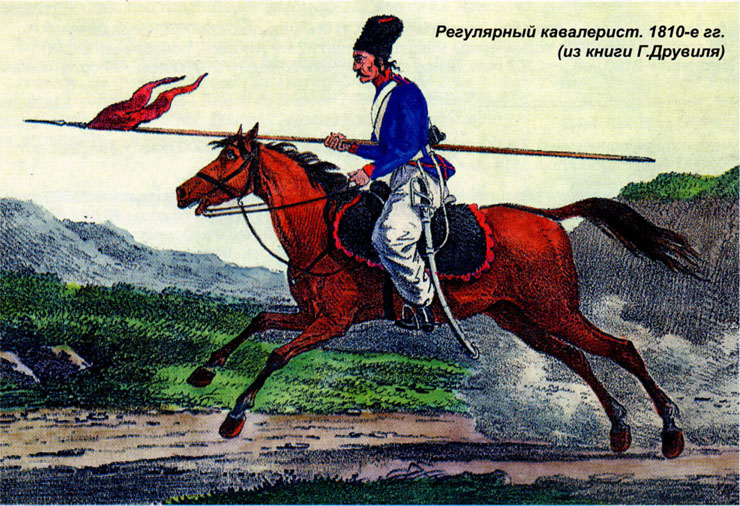
|
| The regular cavalryman. 1810s. (Druvil, 1826) |
In 1813 Fath-Ali-Shah issued standards to the regular cavalry. From drawings they appear the same as infantry flags, but on light-blue cloth, and with a pole that ends in a sharp gilt spearhead rather than the "hand of Ali" (Drouville).
Summing up his observations, Yermolov wrote that the Persian regular cavalry was "much worse" than the irregular mounted troops. In truth, the European equipment constrained oriental horsemen unused to it, and the trading of light Asiastic weapons, with which they had trained since childhood, for heavy items made them even more clumsy. Especially annoying were the spurs - forgetting they had them, the Persians tried to sit with their legs squeezed together in the national style, which naturally stuck the horses painfully. All this led to service in the "traditional" cavalry being considered much less prestigious, and the best horsemen stayed out of the regular forces. The Nizam-Atli quickly fell into decline and by the middle of the 1830’s "it was in the most pitiful state" and "was not capable of any service". In 1835 the English Major Ferrand tried to inspire new life into it by organizing a rather well-structured lancer squadron (120 men), with lances and red clothing (caftans). The European title of "lancers" was apparently of a conditional character. But during the Turkmen campaign of 1836 this squadron practically disappeared, so that in 1837 the red lancers only numbered 30 men.
For comparison, we offer an extract from Murav’ev’s diary. In May of 1817 he was present at a "ristalishche" of 1000 irregular Kruta horsemen (this was one of the nomadic tribes subject to Persia): "The horsemen were amazing in the agility of both themselves and their horses. They were armed with lances with cane shafts. When they attack, holding the lance in the middle over the shoulder, they swing it so that it moves so fast that the eye can hardly follow it, so that the a Kruta thrust is impossible to deflect with a sword. And when the Krutas run away, they fire their pistols, of which they carry three. These pistols are tied by the butt and kept in the waistband; as soon as one is fired, it is tossed back over the shoulder and another is drawn out in a trice." In this way the Europeanized equipment of the regular cavalrymen was only a poor parody of the skillful oriental arrangement. The only deficiency, alas, seen by Murav’ev was what he termed the lack of quickness in the horsemen’s loading of their weapons: "They do not use filled tin or wooden cartridges as do the Circassians, but rather have a leather power bag at the waist, with which they pour a charge into the palm of the hand and then pour it into the barrel. Under windy conditions the powder is always blown out of their hands."
ARTILLERY
Abbas-Mirza wanted to establish regular Persian artillery only in its mounted version. French instructors were only able to accomplish a little in this regard, and the main role in its formation was played by the British, in particular Major Henry Lendisey of the East India Company. "The structure of the regular artillery is completely like that of the English," wrote Yermolov in 1817, " and that which is with the shah as well as that with Abbas-Mirza is all horse artillery. The best men are selected for the Artillery, and as far as they can they are dressed more fancy than the rest of the Persian troops. Abbas-Mirza’s horse artillery fires exceptionally well." By 1837 the regular artillery already numbered 2000 men with 60 guns of various calibers, and according to Blaramberg’s report of what he saw at the siege of Herat, "was fine looking; without doubt it is the best arm of service in Persia."
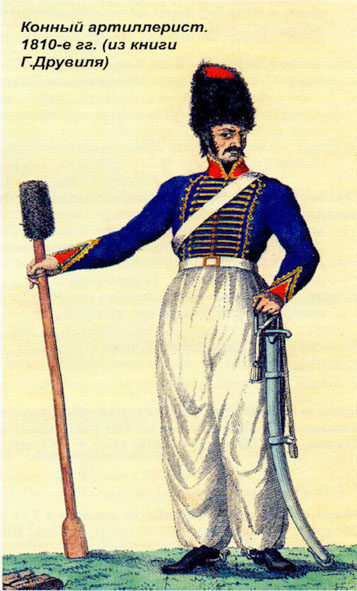
|
| Horse artilleryman. 1810s. (Druvil, 1826) |
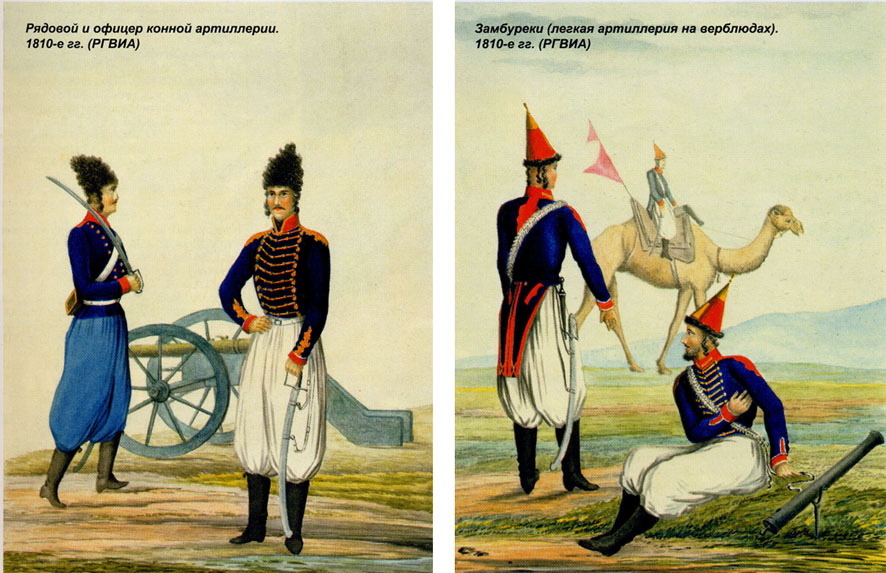
|
|
Private and officer of horse artillery. 1810s. Zambureks (light artillery on the camel). 1810s. Russian State Military History Archive. |
Thus, the artillerymen proved to be the best suited to regular service. Even their uniforms were different from the rest of the sarbaz. "Their uniform consisted of a dark-blue Prussian dolman with red collar and lapels with yellow cords [obviously, we are not talking about a "Prussian", but rather a British Royal Horse Artillery dolman, to which the Persian garment was truly very similar - Auth.], wide white pants, white leather crossbelts, and the national headdress," recalled Drouville about the artillerymen (1812-1813), having seen the instructional artillery squadrons in Tavriz. Afterwards the uniforms of the artillery had almost no changes, and the officers so valued their dolmans that apparently they did not even wear the nizam.
ZAMBUREKS
A special independent branch of the artillery were the "zambureks" - small guns carried on camels. The name comes from the word "zambur", meaning wasp. It was reckoned that artillerymen on camels would be able to annoy the enemy in a manner similar to this insect.
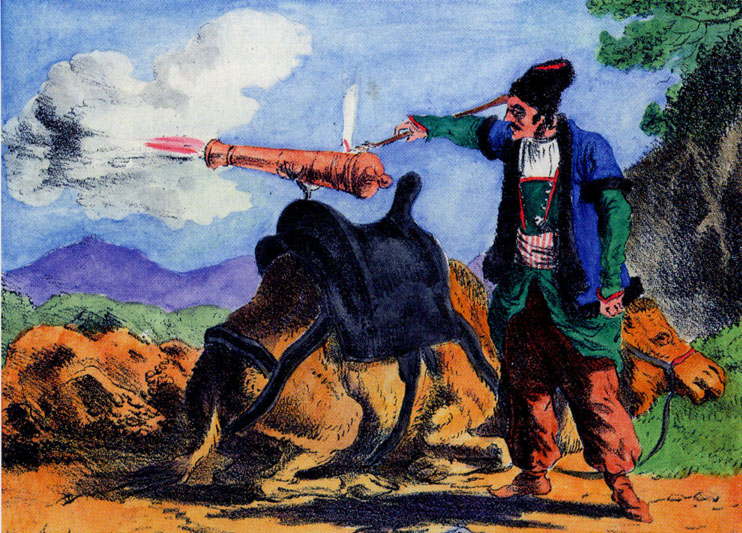
|
| Shooting from a camel. 1810s. (Druvil, 1826) |
Zambureks appeared as early as 1729, when the Persians adopted the idea from their enemies, the Afghans. During the period when a European type army was being created, camel artillery kept their semi-regular status for some time. The zamburek itself was described in 1810 as follows: a bronze falconet of 1/2 pound caliber, fitted with a heavy wooden stock. When firing, it was stood with its stock on the ground and the barrel in a special fork stuck in the earth. The falconet was transported in a wooden saddle with high arches and a felt pillow in the middle. The fork-rest for the barrel was stuck into a special opening in the front arch, while in the back arch was placed the zamburek itself and a long pole with a colored pennant or flag, usually red. The falconets of very small caliber, without a stock, were simply fixed to the fork-rest and not taken off the camels, which during firing were put on their knees. The saddle arch for such a falconet was bound in iron so as to withstand the recoil of firing. For each zamburek the camel carried two leather bags tied to the sides of the saddle, containing powder and balls for twenty shots.
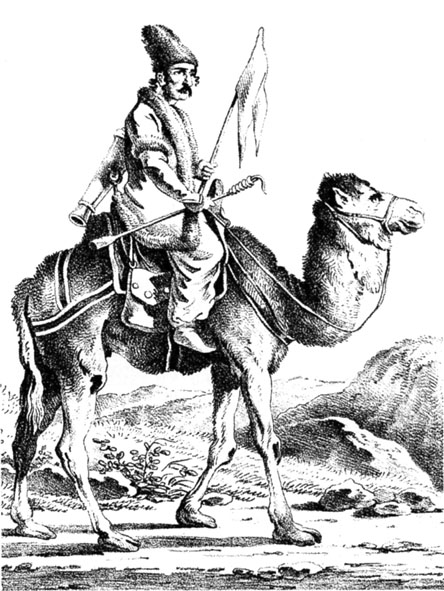
| ||
| Zamburek. 1810s. (Druvil, 1826) |
The shah always had some 400 zambureks, and each prince ruling a province had about 200. According to Yermolov (1817), "zamburechki" (i.e. cannoneers - Auth.) were "dressed in dark-blue coats with red collars, cut in the European style with tails, wide cotton trousers and boots. On the head they had a conical cap colored red. Over the shoulder was throw match cord," the end of which was lit before firing. Zambureks fired no further than a normal musket, and accurately aiming them was almost impossible. This unique weapon was practically useless in battle against regular troops, but very noisy and colorful, very much reflecting the local medieval character, and they enjoyed great popularity with the Persians. For greater effect trumpets and drums accompanied the zambureks to supplement the total noise and din. Some foreigners found the zambureks abominable: "The shah rode alone, and in front went the his guards camel regiment...", we read in Murav'ev's notes (1817). "This guards camel regiment appears very strange to a European. They are all draped with red rags and each serves as a the carriage for a little cannon. They are well trained and can run, it is said, faster than a horse. They growl ungraciously, and stink. Where is the splendor of the Persian court? One sees nothing but rags, filth, and a few pearls."
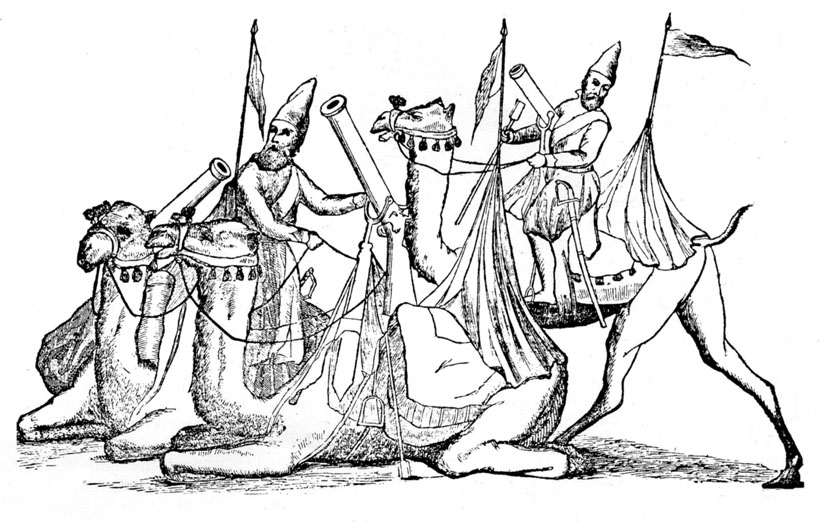
|
| Zamburek with musket stock. |
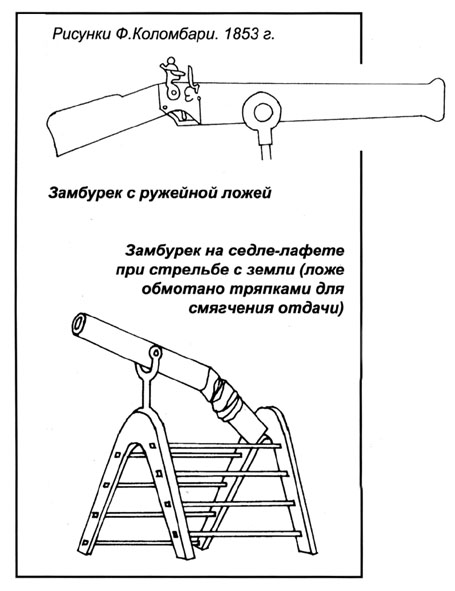
|
| Zamburek on saddle-carriage for firing from the ground (the stock is wrapped with cloth to soften the recoil). Drawings by F. Colombari, 1853. |
The following detailed description of zambureks comes from the year 1853, when Colonel F. Colombari of the the U.S. Army, being a military advisor in Persia, compiled a rather detailed report on the camel artillery. At this time the zamburek artillerymen formed a separate corps of 4 companies (200 men) under the command of a colonel. In addition to the appropriate number of "combatant" camels, there were 25 reserve and pack beasts. There were 25 musicians in the band which was part of the corps. When on campaign, if the camel artillery was operating independently, it was accompanied by horsemen from the irregular cavalry. If such a covering force could not be provided, then an infantryman was seated on each camel behind the cannoneer.
Among the pieces of equipment not referred to by other observers, we may mention a black shabraque which covered the saddle-gun carriage; a leather bag for water hung beneath the camel's belly, and red, blue, and yellow woolen tassels decorating the harness.
The American colonel offered a whole list of improvements in zamburek equipment and wrote suggestions for perfecting the tactics of this mobile artillery.
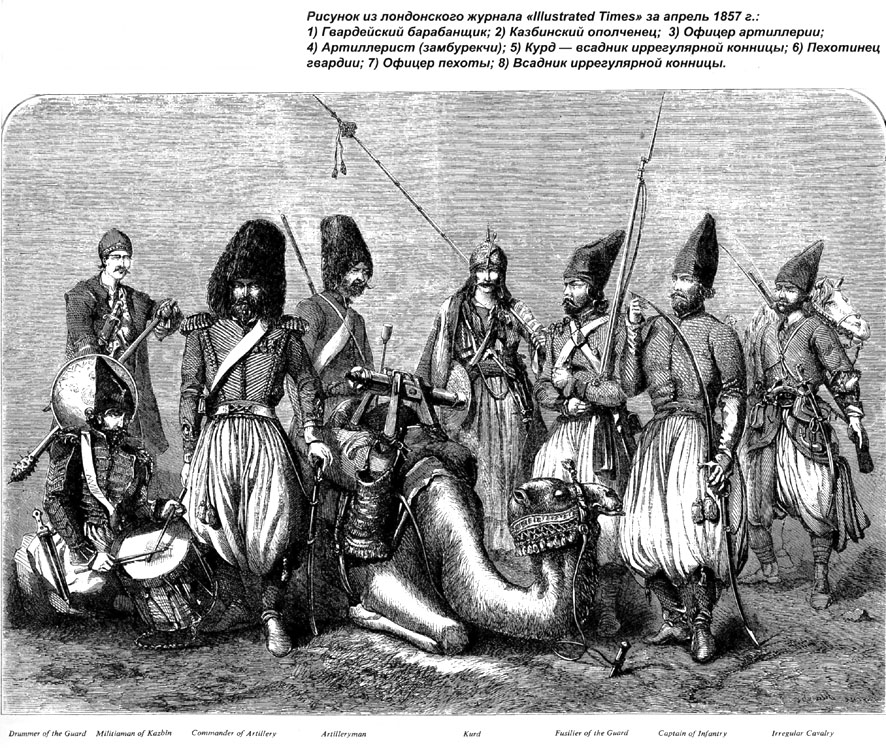
|
|
Drawing from the Illustrated London Times of April, 1857: 1) Guards drummer. 2) Kazbin levy. 3) Artillery officer. 4) Artilleryman (zamburechki). 5) Kurd - mounted irregular. 6) Infantryman of the guards. 7) Infantry officer. 8) Horseman of irregular cavalry. |
In conclusion it is fitting to once more note the superb irregular cavalry outfitted with indigenous equipment and clothing, and also say a few words about the mounted and foot militia - the "tufengdji". The latter consisted of settled and nomad inhabitants who maintained order and - in the Caspian provinces - guarded against Turkmen raids. The total number of such local troops in Persia was about 150,000. The militia had no uniform. Persons wore their normal folk costume, and were armed with swords, daggers, and matchlocks, rarely with flintlocks. Although for their service the government paid them a little money - "tuman" - and a few donkey loads of millet each year, the tufengdji did not recognize anyone's authority or obey anybody except their own leaders. They had a deep distaste for the sarbaz, which sometimes spilled over into bloody fights between militiamen and sarbaz regulars.
In general, all attempts to Europeanize the outer appearance and, especially, the habits of the Persians were never crowned with complete success. Thus, even after the creation of a regular army, soldiers practiced the barbaric custom of cutting off the heads of their slain foes and presenting them to their leaders to receive the prescribed reward. This "tradition" was officially discontinued only after one of the trophies was recognized as the head of an English instructor...
Bibliography:
1. Bartolomei, F.F. Posol'stvo knyazya Menshikova v Persiyu v 1826 godu. Saint Petersburg, 1904.
2. Blaramberg, I.F. Staticheskoe obozrenie Persii [1837].//Zapiski Imperatoroskogo Russkogo Geograficheskogo Obshchestva. Book VII. Saint Petersburg, 1853.
3. Blaramberg, I.F. Osada goroda Gerata [1837].//Sbornik geograficheskikh, topograficheskikh i statisticheskikh materialov po Azii. Issue XVI. Saint Petersburg. 1885.
4. Blaramberg, I.F. Vospominaniya. Moscow. 1978.
5. Bode, K.K. Smert' Griboedova.//"Zhivopisnoe obozrenie". 1879, No. 4.
6. Borozdna, V.P. Kratkoe opisanie puteshestviya Rossiisko-imperatorskogo posol'stva v Persiyu v 1817 godu. Saint Petersburg, 1821.
7. Druvil', G [Drouville]. Puteshestvie v Persiyu v 1812 i 1813 godakh. Parts 1 and 2. Moscow, 1826.
8. Yermolov, P.N. O zavedenii regulyarnykh voisk v Persii. O regulyarnoi Pekhote, Kavalerii i Artillerii, nazyvaemoi Zamburaki [1817]. OPI GIM. f. 93, yed. khr 846 (Sobranie zapisok o Persii v 1817 godu, Book 1); also: RGVIA, f. 446. Op. 1. D. 6.
9. Korf, F.F. Vospominaniya o Persii. 1834-1835. Saint Petersburg, 1838.
10. Masal'skii, N.F. Pis'ma russkogo iz Persii. Parts 1 and 2. Saint Petersburg, 1844.
11. Murav'ev N.N. Zapiski [1817]. //Russkii arkhiv, 1886, No. 4.
12. Saltykov, A.D. Puteshestvie v Persiyu. Pis'ma. Moscow, 1849.
13. "Tradition" [Great Britain], Nos. 37 and 57.
14. GARF. F. 109. I ekspeditsiya. 1829 g. D. 422. Posol'stvo Khazrev-mirzy v Rossiyu.
The authors would also like to thank Aleksei Kotov for his help in obtaining the illustrations for this article.
Illustrations:
Page 28: (Left) Regular cavalryman. 1810's. (From G. Drouville's book.)
(Right) Horse artilleryman. 1810's. (From G. Drouville's book.)
Page 29: (Left) Private and officer of horse artillery. 1810's. (From G. Drouville's book.)
(Right) Zambureks (light artillery on camels). 1810's. (Russian State Military History Archive.)
Page 30: (Left) Firing from a camel. 1810's. (From G. Drouville's book.)
(Right) Zamburek. 1810's. (From G. Drouville's book.)
Page 31: (Top) Drawings by F. Colombari, 1853. Zamburek with musket stock. Zamburek on saddle-carriage for firing from the ground (the stock is wrapped with cloth to soften the recoil).
(Bottom) Drawing from the Illustrated London Times of April, 1857: 1) Guards drummer. 2) Kazbin levy. 3) Artillery officer. 4) Artilleryman (zamburechki). 5) Kurd - mounted irregular. 6) Infantryman of the guards. 7) Infantry officer. 8) Horseman of irregular cavalry.
(End of Part Two.)
*****************************